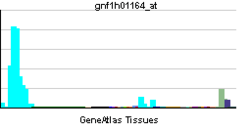SEPT1
| SEPT1 | |||||||||||||||||
|---|---|---|---|---|---|---|---|---|---|---|---|---|---|---|---|---|---|
| Identifiers | |||||||||||||||||
| Aliases | SEPT1, DIFF6, LARP, PNUTL3, SEP1, septin 1 | ||||||||||||||||
| External IDs | MGI: 1858916 HomoloGene: 23009 GeneCards: SEPT1 | ||||||||||||||||
| |||||||||||||||||
| RNA expression pattern | |||||||||||||||||
 | |||||||||||||||||
| More reference expression data | |||||||||||||||||
| Orthologs | |||||||||||||||||
| Species | Human | Mouse | |||||||||||||||
| Entrez | |||||||||||||||||
| Ensembl | |||||||||||||||||
| UniProt | |||||||||||||||||
| RefSeq (mRNA) | |||||||||||||||||
| RefSeq (protein) | |||||||||||||||||
| Location (UCSC) | Chr 16: 30.38 – 30.4 Mb | Chr 7: 127.21 – 127.23 Mb | |||||||||||||||
| PubMed search | [1] | [2] | |||||||||||||||
| Wikidata | |||||||||||||||||
| View/Edit Human | View/Edit Mouse |
Septin-1 is a protein that in humans is encoded by the SEPT1 gene.[3][4]
Function
This gene is a member of the septin family of GTPases. Members of this family are required for cytokinesis. This gene encodes a protein associated with the tau-based paired helical filament core, and may contribute to the formation of neurofibrillary tangles in Alzheimer's disease.[4]
References
- ↑ "Human PubMed Reference:".
- ↑ "Mouse PubMed Reference:".
- ↑ Mori T, Miura K, Fujiwara T, Shin S, Inazawa J, Nakamura Y (Sep 1996). "Isolation and mapping of a human gene (DIFF6) homologous to yeast CDC3, CDC10, CDC11, and CDC12, and mouse Diff6". Cytogenetics and Cell Genetics. 73 (3): 224–7. doi:10.1159/000134343. PMID 8697812.
- 1 2 "Entrez Gene: SEPT1 septin 1".
Further reading
- Nottenburg C, Gallatin WM, St John T (November 1990). "Lymphocyte HEV adhesion variants differ in the expression of multiple gene sequences". Gene. 95 (2): 279–84. doi:10.1016/0378-1119(90)90372-X. PMID 2174398.
- Kinoshita A, Kinoshita M, Akiyama H, Tomimoto H, Akiguchi I, Kumar S, Noda M, Kimura J (November 1998). "Identification of septins in neurofibrillary tangles in Alzheimer's disease". The American Journal of Pathology. 153 (5): 1551–60. doi:10.1016/S0002-9440(10)65743-4. PMC 1853406
 . PMID 9811347.
. PMID 9811347. - Scanlan MJ, Gout I, Gordon CM, Williamson B, Stockert E, Gure AO, Jäger D, Chen YT, Mackay A, O'Hare MJ, Old LJ (March 2001). "Humoral immunity to human breast cancer: antigen definition and quantitative analysis of mRNA expression". Cancer Immunity. 1: 4. PMID 12747765.
- Qi M, Yu W, Liu S, Jia H, Tang L, Shen M, Yan X, Saiyin H, Lang Q, Wan B, Zhao S, Yu L (October 2005). "Septin1, a new interaction partner for human serine/threonine kinase aurora-B". Biochemical and Biophysical Research Communications. 336 (3): 994–1000. doi:10.1016/j.bbrc.2005.06.212. PMID 16179162.
- Rual JF, Venkatesan K, Hao T, Hirozane-Kishikawa T, Dricot A, Li N, Berriz GF, Gibbons FD, Dreze M, Ayivi-Guedehoussou N, Klitgord N, Simon C, Boxem M, Milstein S, Rosenberg J, Goldberg DS, Zhang LV, Wong SL, Franklin G, Li S, Albala JS, Lim J, Fraughton C, Llamosas E, Cevik S, Bex C, Lamesch P, Sikorski RS, Vandenhaute J, Zoghbi HY, Smolyar A, Bosak S, Sequerra R, Doucette-Stamm L, Cusick ME, Hill DE, Roth FP, Vidal M (October 2005). "Towards a proteome-scale map of the human protein-protein interaction network". Nature. 437 (7062): 1173–8. doi:10.1038/nature04209. PMID 16189514.
- Kato Y, Uzawa K, Yamamoto N, Kouzu Y, Koike H, Shiiba M, Bukawa H, Yokoe H, Shibahara T, Tanzawa H (November 2007). "Overexpression of Septin1: possible contribution to the development of oral cancer". International Journal of Oncology. 31 (5): 1021–8. doi:10.3892/ijo.31.5.1021. PMID 17912427.
This article is issued from Wikipedia - version of the 6/6/2016. The text is available under the Creative Commons Attribution/Share Alike but additional terms may apply for the media files.